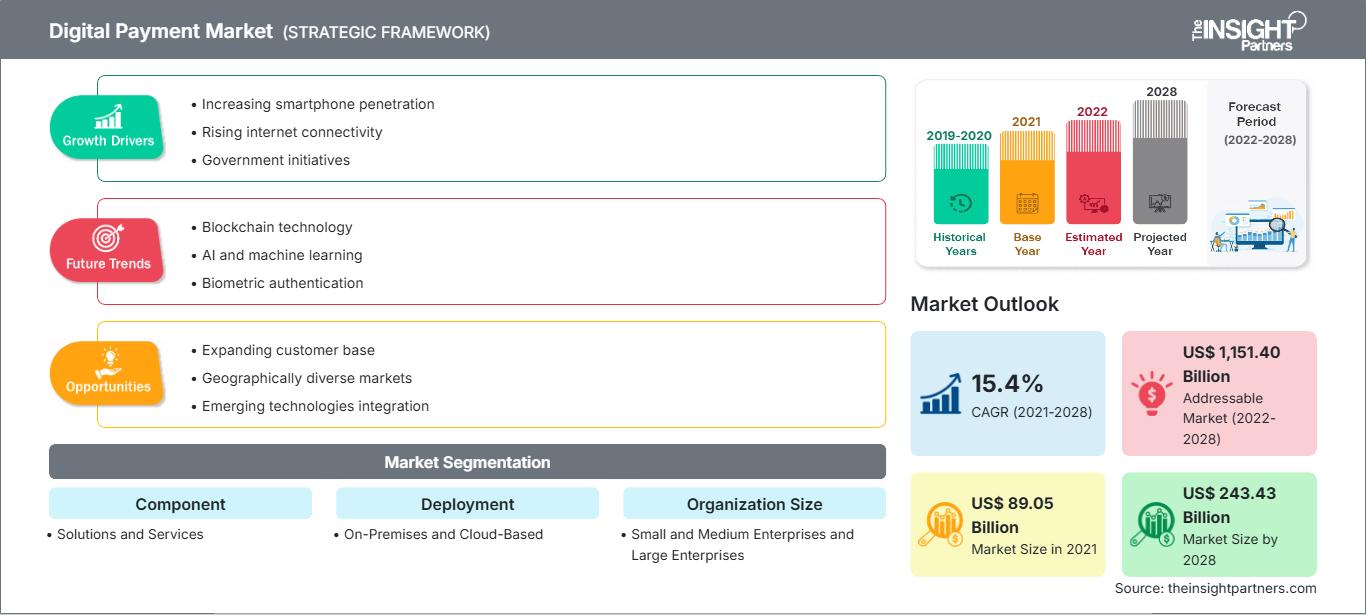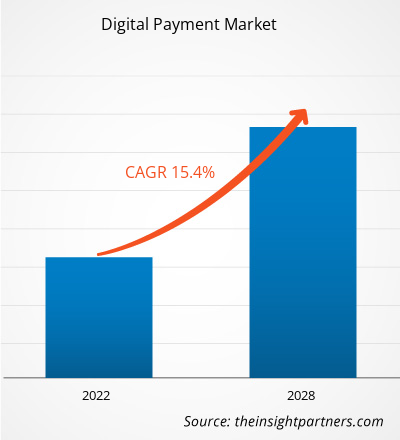Si prevede che il mercato dei pagamenti digitali crescerà da 89.045,67 milioni di dollari nel 2021 a 243.426,71 milioni di dollari entro il 2028; si stima una crescita a un CAGR del 15,4% dal 2021 al 2028.
Si prevede che il mercato globale dei pagamenti digitali crescerà durante il periodo di previsione grazie alla crescente diffusione degli smartphone, che consentirà l'espansione dell'mCommerce. Il modo in cui le persone accedono a Internet ha un impatto diretto sulla crescita del commercio mobile. Gli utenti preferiscono gli smartphone ai PC per navigare in Internet, poiché gli smartphone sono più convenienti e la connessione Internet ad alta velocità non è più un'infrastruttura premium in molti paesi. I rivenditori sviluppano applicazioni di shopping con cataloghi facili da consultare e un'esperienza di pagamento semplice. Il fatto che i clienti siano intrinsecamente legati ai loro telefoni cellulari non è un aspetto trascurato da banchieri e fornitori di servizi di pagamento. Le banche forniscono app bancarie che consentono di completare le transazioni sullo schermo di un dispositivo mobile. Il commercio mobile ha anche cambiato il modo in cui operano le attività commerciali tradizionali, in particolare per quanto riguarda l'accettazione di pagamenti senza contanti. Inoltre, la differenza tra commercio fisico e digitale si sta dissolvendo e i canali stanno convergendo sempre di più. L'esperienza di acquisto in negozio si è notevolmente avvicinata a quella online a causa della forte enfasi sui pagamenti contactless durante la pandemia di COVID-19. Inoltre, prima della pandemia, i pagamenti contactless erano già ampiamente consolidati in alcune regioni. I pagamenti touchless e/o l'identificazione biometrica sono prevalenti nell'esperienza di acquisto online. La carta contactless è il tipo di pagamento touchless più diffuso. I pagamenti mobile, d'altra parte, stanno guadagnando popolarità grazie alla facilità d'uso e alla crescente popolarità delle soluzioni OEM Pay (Original Equipment Manufacturer) come metodo di pagamento al dettaglio. In alcuni paesi, rivenditori e governi chiedono proattivamente ai clienti di aumentare i pagamenti contactless e incoraggiano i rivenditori a renderlo possibile. Molte banche hanno aumentato i limiti dei pagamenti contactless per ridurre la necessità di un touchpad o di contanti presso il punto vendita. Tutti questi fattori guidano la crescita del mercato dei pagamenti digitali.
Potrai personalizzare gratuitamente qualsiasi rapporto, comprese parti di questo rapporto, o analisi a livello di paese, pacchetto dati Excel, oltre a usufruire di grandi offerte e sconti per start-up e università
Mercato dei pagamenti digitali: Approfondimenti strategici

-
Ottieni le principali tendenze chiave del mercato di questo rapporto.Questo campione GRATUITO includerà l'analisi dei dati, che vanno dalle tendenze di mercato alle stime e alle previsioni.
Approfondimenti sul mercato dei pagamenti digitali: crescente adozione di API Open Banking
Le società di servizi finanziari stanno riconoscendo l'importanza delle iniziative di Open Banking e delle interfacce di programmazione delle applicazioni. Le banche tradizionali sono consapevoli della necessità di migliorare le proprie capacità digitali per competere nel settore ed evitare di essere disintermediate da nuovi operatori con offerte e servizi superiori. Ad esempio, numerose società di servizi finanziari come PayPal, Wells Fargo e Visa stanno supportando progetti di Open Banking. Inoltre, in Europa, le iniziative di Open Banking stanno progressivamente diventando la norma, poiché le banche sono legalmente obbligate a rendere accessibili le informazioni sui conti tramite API ai sensi della Direttiva sui servizi di pagamento riveduta (PSD2), in vigore dal 2018. Le API Open Banking aumentano l'attrattiva di una banca e le consentono di soddisfare le mutevoli aspettative dei clienti esistenti e di attrarne di nuovi. Le API possono anche essere utilizzate come soluzione unica nel suo genere per migliorare l'interazione con i clienti e rispondere alle esigenze dei consumatori in modo sicuro, agile e a prova di futuro. Le API di Open Banking rappresentano una risorsa significativa per le organizzazioni di servizi finanziari, poiché consentono loro di ampliare l'offerta di servizi, aumentare l'interazione con i clienti e creare nuovi canali di reddito digitali, il che offrirebbe un'importante opportunità di espansione per il mercato dei pagamenti digitali durante il periodo previsto.Approfondimenti sul segmento di distribuzione
In base alla distribuzione, il mercato dei pagamenti digitali si divide in on-premise e cloud-based. Il segmento cloud-based ha guidato il mercato nel 2020. La distribuzione cloud-based offre sicurezza dei dati integrata, scalabilità on-demand e la capacità di eseguire rapidamente attività di elaborazione intensive. Il cloud è un importante strumento per i portafogli digitali. Con la diffusione dei portafogli digitali, questi vantaggi potrebbero migliorare notevolmente le funzionalità esistenti e persino portare a nuove innovazioni. L'utilizzo di storage virtuale remoto elimina la necessità di server fisici, riducendo il rischio di interruzioni e disastri. I cloud offrono inoltre solide protezioni per la sicurezza informatica e possono soddisfare standard normativi critici, come il Payment Card Industry Data Security Standard (PCI DSS), particolarmente rilevante nel settore dei servizi finanziari.Approfondimenti sui segmenti di mercato per dimensione aziendale
In base alle dimensioni dell'organizzazione, il mercato dei pagamenti digitali si divide in grandi imprese e PMI. Il segmento delle grandi imprese ha guidato il mercato nel 2020 e si prevede che lo dominerà durante il periodo di previsione. Anche per quanto riguarda i sistemi di pagamento, l'adozione tecnologica è fondamentale per ridurre le ridondanze. Per le organizzazioni più grandi, tuttavia, una soluzione unica non funzionerà. L'emergere delle valute digitali delle banche centrali (CBDC) e l'aumento dell'adozione diffusa delle criptovalute sui sistemi di pagamento tradizionali costringeranno molte grandi imprese a includere le valute digitali nelle loro app nei prossimi anni. Queste aziende utilizzeranno le valute digitali principalmente per i pagamenti, come riserva di valore e per sfruttare gli investimenti ad alto rendimento offerti nelle app di finanza decentralizzata (DeFi). Ad esempio, PayG fornisce soluzioni di pagamento personalizzate per le grandi aziende e le aiuta a migliorare i loro metodi di riscossione. Consente alle grandi aziende di tenere traccia dei flussi di cassa in entrata e in uscita e di scalare quando necessario, senza introdurre alcun processo, il che sta guidando la crescita del mercato dei pagamenti digitali.Component Type Segment Insights
In base all'applicazione, il mercato dei pagamenti digitali si divide in soluzioni e servizi. Il segmento delle soluzioni ha guidato il mercato nel 2020. Banche, processori, operatori di telecomunicazioni e commercianti possono utilizzare sistemi di pagamento digitali per effettuare pagamenti digitali in modo fluido e in conformità con gli standard di pagamento internazionali. La soluzione include una piattaforma che controlla il ciclo di vita delle carte digitali. Supervisiona l'intero processo di registrazione, nonché il provisioning e la gestione sicura delle credenziali. Gli emittenti e i fornitori di servizi possono utilizzare la piattaforma per erogare i propri servizi nei propri wallet o in quelli di terze parti, alimentando la crescita del mercato. Il mercato globale dei pagamenti digitali per il segmento delle soluzioni è suddiviso in gateway di pagamento, elaborazione dei pagamenti, sicurezza dei pagamenti e gestione delle frodi, tra gli altri.Gli operatori del mercato dei pagamenti digitali si concentrano su innovazioni e sviluppi di nuovi prodotti integrando tecnologie e funzionalità avanzate per competere. Ad esempio, a gennaio 2021, Okay e FSS Technologies (Financial Software and Systems), un'azienda mondiale di tecnologia per i pagamenti, hanno annunciato la loro alleanza per fornire sicurezza di autenticazione mirata ai pagamenti dei consumatori, in particolare la convalida delle transazioni e l'autenticazione su dispositivi mobili. Con la sua offerta di prodotti, tecnologie e soluzioni di nuova generazione, FSS sta già espandendo il suo potenziale commerciale in Europa. A maggio 2020, Fiserv, Inc. ha acquistato Inlet, LLC ("Inlet"), un fornitore di soluzioni di consegna digitale sicura per fatture ed estratti conto per aziende e medie imprese. Il settore dei pagamenti include Inlet, che promuove la strategia di pagamento digitale delle bollette dell'azienda.
Mercato dei pagamenti digitaliLe tendenze e i fattori regionali che hanno influenzato il mercato dei pagamenti digitali durante il periodo di previsione sono stati ampiamente spiegati dagli analisti di The Insight Partners. Questa sezione analizza anche i segmenti e la geografia del mercato dei pagamenti digitali in Nord America, Europa, Asia-Pacifico, Medio Oriente e Africa, America meridionale e centrale.
Ambito del rapporto sul mercato dei pagamenti digitali
| Attributo del rapporto | Dettagli |
|---|---|
| Dimensioni del mercato in 2021 | US$ 89.05 Billion |
| Dimensioni del mercato per 2028 | US$ 243.43 Billion |
| CAGR globale (2021 - 2028) | 15.4% |
| Dati storici | 2019-2020 |
| Periodo di previsione | 2022-2028 |
| Segmenti coperti |
By Componente
|
| Regioni e paesi coperti |
Nord America
|
| Leader di mercato e profili aziendali chiave |
|
Densità degli operatori del mercato dei pagamenti digitali: comprendere il suo impatto sulle dinamiche aziendali
Il mercato dei pagamenti digitali è in rapida crescita, trainato dalla crescente domanda degli utenti finali, dovuta a fattori quali l'evoluzione delle preferenze dei consumatori, i progressi tecnologici e una maggiore consapevolezza dei vantaggi del prodotto. Con l'aumento della domanda, le aziende stanno ampliando la propria offerta, innovando per soddisfare le esigenze dei consumatori e sfruttando le tendenze emergenti, alimentando ulteriormente la crescita del mercato.

- Ottieni il Mercato dei pagamenti digitali Panoramica dei principali attori chiave
- ACI WORLDWIDE, INC
- Adyen
- Software finanziario e amp; Sistemi Pv. Ltd.
- Fiserv, Inc.
- Global Payments Inc.
- Novatti Group Ltd
- PayPal Holdings, Inc.
- Paysafe Limited
- Block, Inc.
- PayU
- Analisi storica (2 anni), anno base, previsione (7 anni) con CAGR
- Analisi PEST e SWOT
- Valore/volume delle dimensioni del mercato - Globale, Regionale, Nazionale
- Industria e panorama competitivo
- Set di dati Excel
Report recenti
Rapporti correlati
Testimonianze
Motivo dell'acquisto
- Processo decisionale informato
- Comprensione delle dinamiche di mercato
- Analisi competitiva
- Analisi dei clienti
- Previsioni di mercato
- Mitigazione del rischio
- Pianificazione strategica
- Giustificazione degli investimenti
- Identificazione dei mercati emergenti
- Miglioramento delle strategie di marketing
- Aumento dell'efficienza operativa
- Allineamento alle tendenze normative






















 Ottieni un campione gratuito per - Mercato dei pagamenti digitali
Ottieni un campione gratuito per - Mercato dei pagamenti digitali